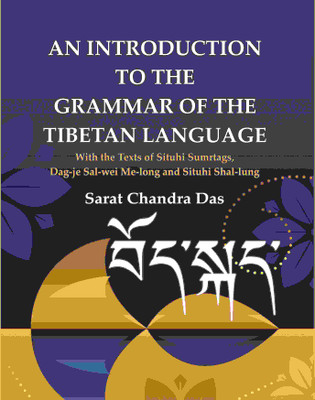An Introduction to The Grammar of The Tibetan Language: With the Texts of Situhi Sumrtags, Dag-je Sal-wei Me-long and Situhi Shal-lung(Paperback, Sarat Chandra Das)
Quick Overview
Product Price Comparison
About The Book: The present work is designed not only to help the general reader to grasp the grammatical structure of the Tibetan language in his endeavour to study the general literature of Tibet but also the Buddhist scholar who is particularly interested in the vast Tibetan literature which includes almost all the Buddhist works of India. It will prove equally useful for a Sanskrit student who will discover herein a key to unlock the immense volumes faithful translations of the Sanskrit texts which exist in Tibetan language on the manners, customs, opinions, knowledge, ignorance, superstitions, hopes and fears of the great part of Asia, especially, India in former days. The work contains all the requisites of an elementary grammar. It undertakes to analyse and classify the grammatical forms of the Tibetan language. It recounts all the parts of Speech, the Declension and Conjugation systems, Pronunciation, Syntax and Prosody. As exercises in grammatical rules it contains specimens of composition from the standard works, particularly the extracts from the text of Situ Sum-Tag, the exhaustive commentary on Thonmi Sam Bhota's Sum-Chu-pa, Tag-jug-pa, Dag-je-Salwai Melong and others. In this work the author has followed the monumental work of Alexander Csoma de Koros, supplementing it here and there with materials drawn from Situ-Sum-Tag, the exhaustive commentary on Thonmi Sam Bhota's Sum-Chu-pa and Tag-jug-pa. About The Author: Sarat Chandra Dash (18 July 1849 ŌĆō 5 January 1917) was an Indian scholar of Tibetan language and culture most noted for his two journeys to Tibet in 1879 and in 1881ŌĆō1882. Born in Chittagong, eastern Bengal to a Bengali Hindu Vaidya-Brahmin family, Sarat Chandra Dash attended Presidency College, as a student of the University of Calcutta. In 1874 he was appointed headmaster of the Bhutia Boarding School at Darjeeling. In 1878, a Tibetan teacher, Lama Ugyen Gyatso arranged a passport for Sarat Chandra to go the monastery at Tashilhunpo. In June 1879, Das and Ugyen-gyatso left Darjeeling for the first of two journeys to Tibet. They remained in Tibet for six months, returning to Darjeeling with a large collection of Tibetan and Sanskrit texts which would become the basis for his later scholarship. Sarat Chandra spent 1880 in Darjeeling poring over the information he had obtained. In November 1881, Sarat Chandra and Ugyen gyatso returned to Tibet, where they explored the Yarlung Valley, returning to India in January 1883. Along with Satish Chandra Vidyabhusan, he prepared Tibetan-English dictionary.


